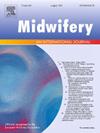硬膜外镇痛分娩后剖宫产的发生率及相关因素:泰国一所大学医院的前瞻性队列研究
IF 2.5
3区 医学
Q1 NURSING
引用次数: 0
摘要
背景局麻药和阿片类药物联合硬膜外镇痛对分娩疼痛的控制非常有效。然而,它可能会影响剖宫产率。本研究探讨硬膜外分娩镇痛后剖宫产的发生率及其相关因素。方法我们在泰国最大的大学医院进行了一项前瞻性队列研究。我们招募了18岁以上接受硬膜外分娩镇痛的妇女,不包括那些不能用泰语交流的妇女。数据来自产时硬膜外受者。Logistic回归分析确定了与剖宫产相关的因素,以校正优势比(AORs)表示,95%可信区间(CIs)。结果共纳入182例患者,其中54例(29.7%);95% CI(23.5-36.7)行剖宫产。器械分娩包括23例真空抽出(12.6%)和1例钳抽出(0.5%)。多因素分析确定了三个与剖宫产显著相关的因素。其中包括患者年龄;27岁(AOR 2.708;95% ci 1.291-5.679;P = 0.008),无阴道分娩史(AOR 3.865;95% ci 1.668-8.958;P = 0.002)。新生儿体重;3270 g (AOR 4.870;95% ci 2.356-10.036;P & lt;0.001)也具有显著性。硬膜外插入后的平均疼痛评分(数值评定量表)从8.5±1.7降至2.2±2.2 (P <;0.001)。结论接受硬膜外镇痛的患者中约有三分之一选择剖宫产。产妇年龄、有无阴道分娩史和新生儿体重增高与剖宫产显著相关。患者在接受硬膜外镇痛前应告知这些因素。本文章由计算机程序翻译,如有差异,请以英文原文为准。
Incidence and associated factors of cesarean delivery following epidural analgesia for labor: A prospective cohort study at a Thai university hospital
Background
Epidural analgesia with local anesthetics and opioids is highly effective for labor pain control. However, it may influence cesarean delivery rates. This study examined the incidence of cesarean delivery and its associated factors following epidural labor analgesia.
Methods
We conducted a prospective cohort study at the largest university hospital in Thailand. We enrolled women older than 18 years who received epidural labor analgesia, excluding those who could not communicate in Thai. Data were collected from intrapartum epidural recipients. Logistic regression analysis identified factors associated with cesarean delivery, presented as adjusted odds ratios (AORs) with 95 % confidence intervals (CIs).
Results
A total of 182 patients were included, and 54 (29.7 %; 95 % CI 23.5‒36.7) underwent cesarean delivery. Instrumental deliveries included 23 vacuum extractions (12.6 %) and 1 forceps extraction (0.5 %). Multivariate analysis identified three factors significantly associated with cesarean delivery. These included patient age > 27 years (AOR 2.708; 95 % CI 1.291‒5.679; P = 0.008) and no history of vaginal delivery (AOR 3.865; 95 % CI 1.668‒8.958; P = 0.002). Neonatal weight > 3270 g (AOR 4.870; 95 % CI 2.356‒10.036; P < 0.001) was also significant. Mean pain scores (numeric rating scale) decreased from 8.5 ± 1.7 to 2.2 ± 2.2 after epidural insertion (P < 0.001).
Conclusion
Approximately one-third of patients who received epidural analgesia underwent cesarean delivery. Maternal age, lack of prior vaginal delivery, and higher neonatal birth weight were significantly associated with cesarean delivery. Patients should be counseled about these factors before receiving epidural analgesia.
求助全文
通过发布文献求助,成功后即可免费获取论文全文。
去求助
来源期刊

Midwifery
医学-护理
CiteScore
4.50
自引率
7.40%
发文量
221
审稿时长
13.4 weeks
期刊介绍:
Midwifery publishes the latest peer reviewed international research to inform the safety, quality, outcomes and experiences of pregnancy, birth and maternity care for childbearing women, their babies and families. The journal’s publications support midwives and maternity care providers to explore and develop their knowledge, skills and attitudes informed by best available evidence.
Midwifery provides an international, interdisciplinary forum for the publication, dissemination and discussion of advances in evidence, controversies and current research, and promotes continuing education through publication of systematic and other scholarly reviews and updates. Midwifery articles cover the cultural, clinical, psycho-social, sociological, epidemiological, education, managerial, workforce, organizational and technological areas of practice in preconception, maternal and infant care.
The journal welcomes the highest quality scholarly research that employs rigorous methodology. Midwifery is a leading international journal in midwifery and maternal health with a current impact factor of 1.861 (© Thomson Reuters Journal Citation Reports 2016) and employs a double-blind peer review process.
 求助内容:
求助内容: 应助结果提醒方式:
应助结果提醒方式:


